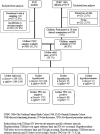Maternal thyroid dysfunction during pregnancy and thyroid function of her child in adolescence
- PMID: 23408571
- PMCID: PMC3590485
- DOI: 10.1210/jc.2012-2028
Maternal thyroid dysfunction during pregnancy and thyroid function of her child in adolescence
Abstract
Context: Normal maternal thyroid function is important for fetal development. No knowledge exists on how maternal thyroid function and thyroid antibodies during early pregnancy affect thyroid function of the offspring.
Objective: The aim of this study was to investigate the relationship between maternal and adolescent thyroid function parameters.
Design, setting, and participants: A total of 3673 mother-child pairs from the prospective, population-based Northern Finland Birth Cohort 1986 participated in the study. Maternal serum samples were drawn in early pregnancy (<20th gestational week), and children's samples were drawn at the age of 16 years and analyzed for TSH, free T4 (fT4), and thyroid peroxidase antibodies (TPO-Abs).
Main outcome measures: TSH, fT4, and TPO-Ab concentrations were measured at the age of 16 years. Children of mothers with thyroid dysfunction (hypothyroidism, hyperthyroidism, or hypothyroxinemia) or TPO-Ab positivity were compared to those of euthyroid or TPO-Ab-negative mothers. The distributions are expressed as medians with 5th to 95th percentiles.
Results: Boys of hypothyroid mothers had higher TSH concentrations than those of euthyroid mothers: 2.0 (0.9-4.0) vs 1.7 (0.8-3.3) mU/L; P = .001. Children of hyperthyroid mothers had lower TSH concentrations than those of euthyroid mothers: 1.3 (0.6-4.2) vs 1.7 (0.8-3.3) mU/L, P = .013, for boys; and 1.3 (0.5-3.5) vs 1.6 (0.7-3.4) mU/L, P = .034, for girls. There were no differences in TSH or fT4 concentrations between children of hypothyroxinemic and euthyroid mothers. TPO-Ab-positive mothers more often had TPO-Ab-positive children (prevalence, 9.0 vs 3.7% among boys, and 22.7 vs 7.5% among girls).
Conclusions: Maternal thyroid dysfunction and TPO-Ab positivity during pregnancy seem to modify thyroid function parameters of offspring even in adolescence. Whether this increases the thyroid disease risk of the children is still unknown.
Figures
References
-
- Casey BM, Dashe JS, Wells CE, et al. Subclinical hypothyroidism and pregnancy outcomes. Obstet Gynecol. 2005;105:239–245 - PubMed
-
- Burrow GN, Fisher DA, Larsen PR. Maternal and fetal thyroid function. N Engl J Med. 1994;331:1072–1078 - PubMed
-
- Calvo RM, Jauniaux E, Gulbis B, et al. Fetal tissues are exposed to biologically relevant free thyroxine concentrations during early phases of development. J Clin Endocrinol Metab. 2002;87:1768–1777 - PubMed
-
- Malek A, Sager R, Kuhn P, Nicolaides KH, Schneider H. Evolution of maternofetal transport of immunoglobulins during human pregnancy. Am J Reprod Immunol. 1996;36:248–255 - PubMed
-
- Kaloumenou I, Mastorakos G, Alevizaki M, et al. Thyroid autoimmunity in schoolchildren in an area with long-standing iodine sufficiency: correlation with gender, pubertal stage, and maternal thyroid autoimmunity. Thyroid. 2008;18:747–754 - PubMed
Publication types
MeSH terms
Substances
LinkOut - more resources
Full Text Sources
Other Literature Sources
Medical
Research Materials



